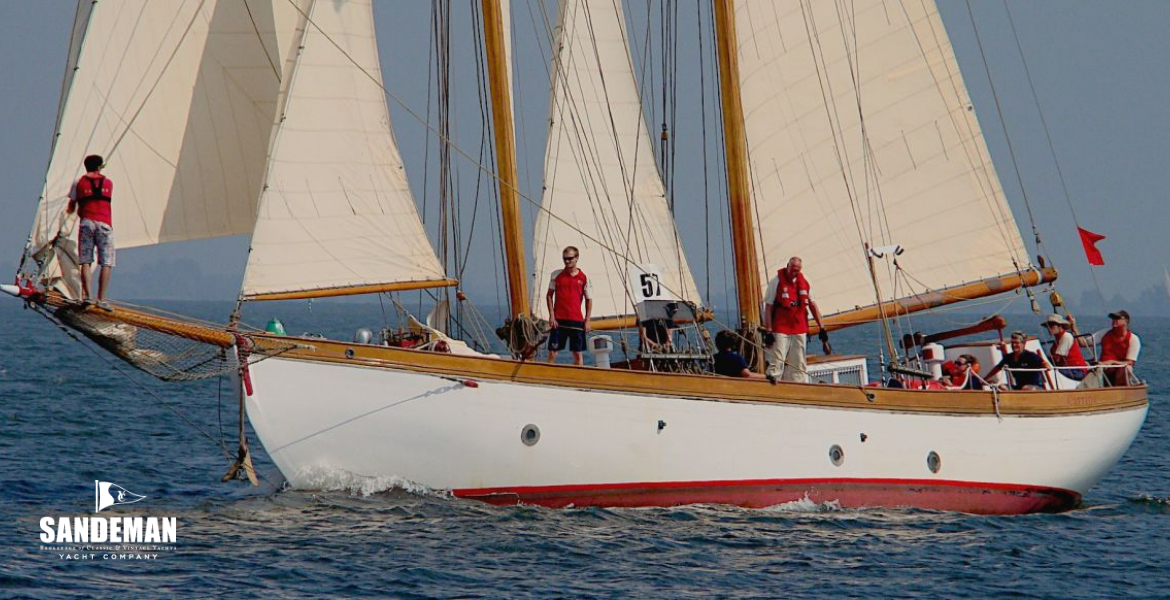
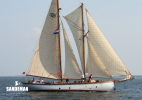
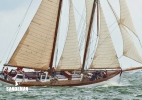
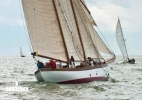
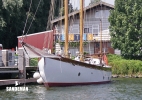
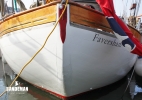
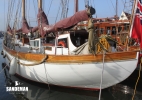
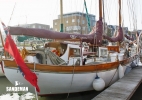
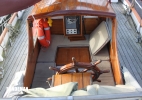
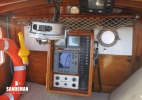
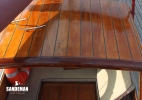
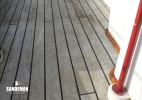
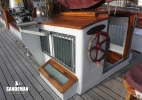
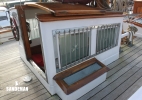
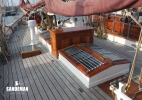
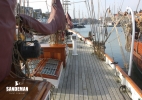
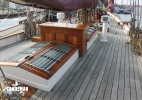
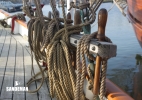
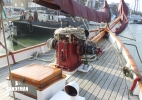
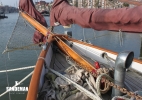
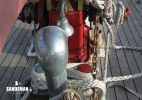
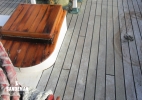
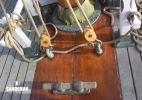
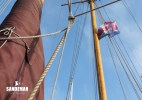
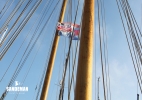
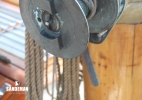
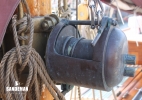
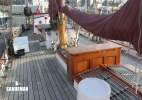

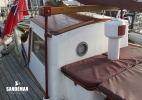
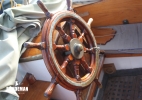
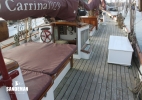
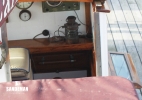
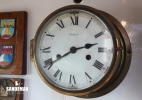
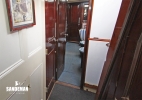
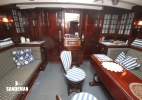
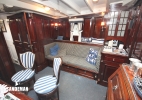
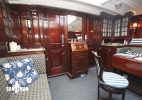
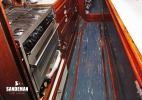
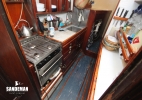

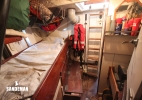
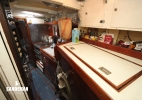
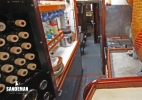
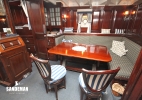
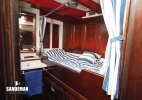
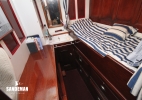
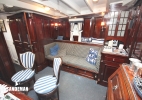
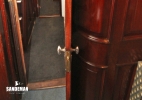
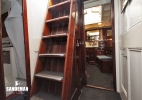
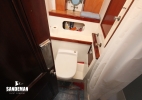
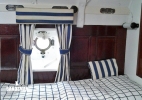


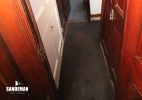
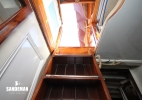
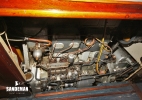
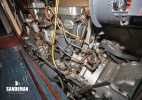
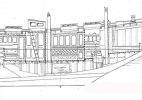
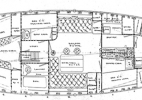
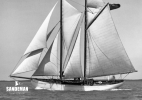
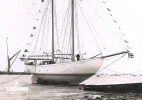
| Designer | Fred Shepherd |
|---|---|
| Builder | R.J. Perkins & Sons, Whitstable |
| Date | 1929 |
| Length overall | 65 ft 11 in / 20.1 m |
| Length deck | 54 ft 2 in / 16.5 m |
| Length waterline | 42 ft 0 in / 12.8 m |
|---|---|
| Beam | 13 ft 5 in / 4.1 m |
| Draft | 9 ft 0 in / 2.74 m |
| Displacement | 39 Tonnes |
| Construction | Burma teak on grown oak frames |
| Engine | Gardner 4LW Diesel 62 hp at 1,500 rpm |
|---|---|
| Location | Netherlands |
| Price | EUR 385,000 |
These details are provisional and may be amended
Many yacht designers achieved fame through the prowess of their racing yachts. Fred Shepherd by contrast is famous for cruising boats; always beautiful with the sweetest sheers, and spacious and thoroughly well thought out accommodation. CARRINA has much of her original detail - indeed her interior joinery, exquisite at build, remains so to this day. With her handy rig it is not hard to imagine her cruising in the 1930s for her owner and guests with just two crew, or easily criss-crossing the Atlantic to be one of the first charter boats in the burgeoning Caribbean scene of the 1950s. CARRINA epitomises not only the skill of her designer but the very essence of an English yacht.
Interested in CARRINA in more detail.
Despite the genius of her designer and the excellent craftsmanship of the shipwrights it is well recognised that a classic yacht can only survive through the careful maintenance of her successive owners.
Over the years the Staniland family did many refits at Camper & Nicholsons and in Malta. Initially the masts were unstepped and a track added to the main mast and 10 ft cut off the main boom, to convert her to a Bermudian staysail schooner for easy handling in the Caribbean. The old main gaff was converted into the present square yard with 6 ft scarfed in. The cockpit shelter aft was added in 1956 at C & N. In 1966 the boat was completely re wired and received a new electrical panel, new main engine beds and a new diesel engine; the Gardner 4LW. In 1973/74 father and son Staniland renewed the decks with 2 layers of 3/8th inch marine ply screwed to the beams and 1inch teak. They hand screwed 6,000 silicon bronze screws into this deck.
Subsequent refits included
- New Gardner 4LW marine Diesel engine installed in 1966 / 67
- Decks re laid in 1973/74; 1inch teak planking over 2 layers of 3/8th inch marine plywood
- Fastened with silicon bronze screws
1992 intensive maintenance in Spain
2003-2004 Major refit in Mallorca
- Hull stripped to bare wood
- One plank around stern gland replaced
- Stem renewed with green wood
- Careful maintenance of the deadwood
- Hull planking re caulked in the properly traditional way
- New modern electronics installed
- New electric wiring: 220V / 24V / 12V
- Modern drinking water system, including boiler
- Hull completely repainted with new system from bare wood
In the years 2009 and 2010 all the stanchions are renewed and intensive control and maintenance of the masts and spars did took place. Also complete new varnishing and painting masts, spars, hull and deck housing.
Leaks around the oak stanchions required their total replacement along with the bulwarks. The stanchions supporting the bulwark and capping-rail had deteriorated through years of exposure to salt and fresh water. Without removing the original teak deck-planking and covering board but reusing the original capping-rail, the original mahogany interior panels, had to be completely removed.
The stanchions have been replaced by Guariuba. This wood; yellow in colour is quite resistant to fungi and dry wood borers. The full bulwark is now finished in teak and varnished, while it should be noted the original bare hull planking was still found in perfect condition.
Upon inspection the shipwrights also found some rot in the main mast; now repaired without compromising strength. The masts and spars are believed to have dated from 1946, evidenced by a silver florin dated that year found under the main mast.
Commissioned for a Captain Westray, CARRINA was designed as an auxiliary centre shaft gaff ketch by Fred Shepherd and her build to Lloyds 18 A1 started in 1914 by R.J. Perkins & Sons in Whitstable. The hull was completed with deck housings but no deck when the Great War broke out and the captain subsequently killed in action. Kept in a shed for the duration of the War and beyond, her first 15 years therefore were spent drier than expected and in retrospect it was perfect seasoning for the fine Burmese teak and English oak frames, fastened with copper and bronze simply to have waited to be launched eventually in 1929 for Mr G.F Carrington.
Although, CARRINA had been designed as a ketch she was never built as such. On launching in 1929 it was as a staysail schooner. Whereas normally the space between the fore and main masts takes a boomed staysail, here the gap between the masts is filled with a wishbone sail almost above the boomed staysail. The advantage is, she is easily handled and reefed by a small crew – Tacking is easier as the boomed sails are self-tacking without the need for sheet handling.
During the Thirties, she was de-rigged every winter, her masts taken down and stored indoors at Camper & Nicholsons, Southampton (now Shamrock Quay).
CARRINA was the first (European) yacht with a running wishbone sail. Between 1934 and the outbreak of the 2nd World War, she sailed mostly with the owner at the helm and a small 2 man professional crew, in the Channel and as far as Casablanca and the Canaries as well as the Baltic. She was even in Kiel harbour shortly before the start of the War. She survived that war, de-rigged in a mud berth at Camper & Nicholson’s with the spars stored ashore in a shed. All of these McGruer spars were destroyed during the Southampton blitz, except for what is now the main staysail boom - and the gaff which is nowadays used as the square yard.
After the War, when CARRINA came out of hiding she sailed in the Channel out of Poole in Dorset; the family enjoying a lot of mackerel fishing. During an onshore gale, while in Portland harbour, her anchors dragged and she was almost dashed against some concrete defence emplacements left in the middle of the harbour – but saved from disaster by a Royal Navy launch.
From 1947 to 1953 when the Staniland family bought her CARRINA cruised quite extensively around England and to France and Spain.
Some significant changes were made by the Stanilands. In 1956 the cockpit shelter aft was added at Campers and in 1966 there was a major refit in Malta. The Stanilands cruised and lived aboard CARRINA for 29 years averaging about 5,000 miles a year and during their ownership CARRINA made 6 Atlantic crossings. Their son Ian, born on board subsequently made his own crossing in 1969 earning in his own right membership of the Ocean Cruising Club of which his parents had been founder members.
Ownerships recorded as
1929 1934 George Frederick Carrington
1934 1944 Harold Francis Blackborow
1944 1948 Henry Stanley Whiteside
1948 1950 Mary Lorna Berthon
1950 1953 Harry Montague Pinney
1953 1953 Edith Pinney jointly with Richard Grosvenor Pinney
1953 1973 John Charles Staniland
1973 1982 John Charles Staniland, jointly with Mildred Claire Staniland and Ian Staniland
1982 1984 Deborah Grey Bellamy
1984 2003 John Christopher Horton
2003 to date Willem van der Velde
Given the high skills and quality of her build CARRINA is a wonderful example of the English Maritime heritage. That she survived her first century should also be attributed to the successive owners have maintained her throughout with tender loving care.
Built to Lloyds class 18 A1 with the special skills and craftsmanship of the early C 20th for which the English shipwrights were so famous. Fred Shepherd made several personal notes on his drawings. For example “…The shipwrights should use only the best Burma teak planking (not Java) and grown frame double timbers of English oak ……also lead keel bolts 1 3/8th & 1 ¼ inch” Thanks to his insistence on these high standards, the vessel remains in astonishing condition. The essential details are:
- Best quality Burmese teak 1 5/8th inch hull planking on English grown oak frames
- Fastened with Copper and Bronze
- 15 tons lead external ballast
- 8 x Naval Bronze keel bolts
- Heavy forged bronze framed rudder with teak facing pieces
- Strapped hull with wrought iron galvanized floors and hanging knees
- Galvanized wrought iron breast hooks
- Teak decks
- Teak superstructure
- Mahogany interior joinery
CARRINA’s interior deserves special mention. Only the finest Honduran mahogany was used in its construction; hand crafted and French polished by Robertson’s of London, who were accredited with fitting out some of London’s most prestigious shops at that time. The interior remains almost as intact as the day she was fitted out. Thus in the cabins, the original plated pumps and marble top wash basins are still in place, as is the French polished mahogany panelling. The gimballed dining table and fixed mounted turning chairs are all original and wonderfully preserved with the patina that only comes with age and imbuing the atmosphere of the thirties yachting era.
From aft
- Chromed fairleads port and stbd over canoe stern
- Mainsheet horse
- Ash mainsheet blocks
- Bronze vents port and stbd either side of helm
- Schooner helm wheel and engine controls
- Steering gear in wooden box abaft the wheel
- Aft cockpit
- Teak grating sole
- Access to deep lazarette via hatch in the cockpit
- Navigation instruments, electronics and engine controls by helm wheel
- Deck house with white painted sides and varnished teak roof
- Bench seating either side
- Varnished boom gallows over deck house
- Lockers port and stbd fwd
- Butterfly skylight hatch fwd with sun bed facility over
- Laurent Giles Myth running backstay and adjuster levers
- Deck box to stbd
- Original doghouse; white painted with teak roof
- 2 x Bronze Panama fairleads each side; 4 in all
- Single spreader main mast
- Original bronze main halyard winch
- Appledore reefing
- Pin rail at base of mast acting as stops for fore Mast
- Ash blocks fore mast main sheet
- Pin rails at main mast shroud bases
- Butterfly hatch skylight over saloon
- Varnished teak box for gas bottles
- Butterfly hatch skylight
- 2 x Tall ventilator cowls; one each side
- Hatch over galley
- Pin rail P&S for main mast
- Pin rail at base of fore mast acting as stop for staysail
- Fore mast with wish bone above swept back single spreaders
- 2 x Bronze halyard winches
- Varnished raised fore hatch
- Dorade vent to stbd
- Original Hyland hydraulic anchor windlass with two winch drums
- Large galvanised mooring cleat
- Panama eye fairleads port and stbd
- Tall chromed Simpson Lawrence ventilator
- Bowsprit foot mounted through painted metal deck fitting
- Bowsprit with spreaders and bobstay
- CQR anchor stowed ready rigged on stem
- Bronze anchor hause either side of bowsprit
- Inflatable tender with Honda 13.5 HP petrol outboard
Companionway steps down from mid dog house and corridor forward to
Saloon
- Beautifully crafted original Honduras mahogany panelling by Robertson’s of London
- Opening butterfly hatch over
- Settee berth to port
- Original gimballed dining table and 2 x original chairs
- L shaped settee berth to stbd
- 4 x Gimballed chromed bulkhead lights
- 4 x Original art deco deck head lights
- 2 x Opening ports; one each side
Forward port side to galley in original joinery
- Large top loading fridge
- Stainless steel sink with hot and cold mixer
- Blake seawater pump and tap
- Force 10 3 burner hob and oven
Foc’sle
- 2 x Berths
- Sail stowage anchor locker
- Tool stowage
- Fridge freezer
- Companionway steps to raised fore deck hatch
- Corridor aft to saloon
Saloon doorway stbd side fwd to owners mahogany panelled cabin
- Single berth to stbd with stowage in drawers under
- Basin fwd to port with original chromed hand pump
- Butterfly hatch over
Aft through saloon to guest cabin to port in original joinery
- Large single berth with stowage under
- Porcelain basin with original hand pump
- Opening port and art deco light
- Small hatch, part of doghouse in deckhead
Head compartment to stbd by companionway steps
- Electric WC and shower
- Opening port
- Small hatch; part of the doghouse in deck head
Aft corridor to ladies cabin in fine original mahogany joinery
- 2 x Large berths; one each side with bookcases outboard and drawers under
- 2 x Hanging wardrobes; one each side
- Porcelain basin between berths with chromed hand pump
- 2 x Small couchettes; one each side
- Butterfly skylight hatch over
RIG
- Columbian pine spars (1945)
- Stainless steel standing rigging – Norseman fittings
- 3-strand Marlow running rigging
- 1 x 2-speed bronze halyard winch
- 2 x Single-speed bronze halyard winches; all self winding cable
- Boom with roller reefing and traditional square sail
- Mainstay sail boom is the original McGruer of 1929
- Square yard is the original McGruer former gaff of1929
SAILS
Up to 2,034 sq ft / 189 sq m sail area
- 1 x Main
- 1 x Main stay sail
- 1 x Flying Jib
- 1 x Jib
- 1 x Fore stay sails
- 1 x Full width raffee (triangular topsail)
- 1 x Square sail
- 1 x Yankee jib
- 1 x Genneker
MECHANICAL
- Gardner, 4LW 62 hp / 46.25 kW marine Diesel engine (1967)
ELECTRICAL
- New wiring and equipment at boatyard Palma, Mallorca 2004
- Main electrical system: 24 V – also available: 12 V / 220 V and 110 V possible
- Shore power (isolation) transformer
- Vectron Marine battery charger / inverter 24 V / 3000 Va / 70 A
- Bosch high output alternator - 24 V / 85 Ah
- Alpha regulator
- CAV engine alternator
- Emergency Start wiring – service batteries to start engine
- Mastervolt battery monitor system
- Gel 600 Ah service batteries
- Gel 85 Ah starter battery
- 1 x 24 to 12 V converter (1967)
- 1 x 24 to 12 V converter (2004)
- 230 V AC to 110 V AC transformer – spare (old)
TANKAGE
- Fuel tank capacity 73 Imp Gal / 332 L
- Fresh water tank capacity 224 Imp Gal / 1,020 L
- Sestrel steering compass
- Raymarine SRC70C radar and chart plotter
- Raymarine ST60 tri data
- Raymarine ST60 wind
- Celeste brass bound clock
- Aneroid barometer
- 6-person inflatable life craft
- 8 x life jackets
- 1 x safety light buoy
- Set of emergency / distress flares
Contact us to discuss CARRINA in more detail.
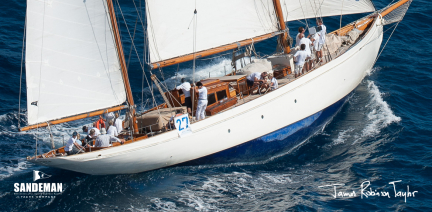
| Name | MILENA |
|---|---|
| Designer | Fred Shepherd |
| Builder | White's Southampton Yachtbuildling & Engineering Co Ltd |
| Date | 1928 |
| Length deck | 80 ft 1 in / 24.4 m |
| Beam | 15 ft 1 in / 4.6 m |
| Draft | 9 ft 10 in / 3 m |
| Displacement | 60 Tons |
| Location | France |
| Price | EUR 1,100,000 |
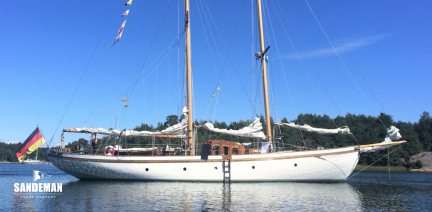
| Name | ELLA (ex VELEDA) |
|---|---|
| Designer | Fred Shepherd |
| Builder | J N Miller & Sons St Monans Fife |
| Date | 1935 |
| Length deck | 67 ft 0 in / 20.42 m |
| Beam | 15 ft 0 in / 4.57 m |
| Draft | 10 ft 0 in / 3.05 m |
| Displacement | 75 Tons |
| Location | Germany |
| Price | POA |
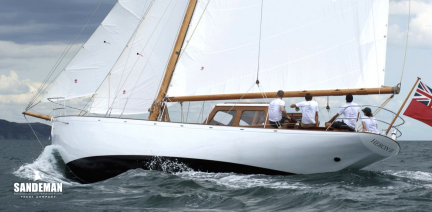
| Name | HERON II |
|---|---|
| Designer | Fred Shepherd |
| Builder | Woodnutt & Co., St Helens, I.O.W. |
| Date | 1936 |
| Length deck | 46 ft 3 in / 14.1 m |
| Beam | 11 ft 4 in / 3.45 m |
| Draft | 6 ft 6 in / 1.98 m |
| Displacement | 20 Tons |
| Location | France |
| Price | GBP 395,000 |
These particulars have been prepared from information provided by the vendors and are intended as a general guide. The purchaser should confirm details of concern to them by survey or engineers inspection. The purchaser should also ensure that the purchase contract properly reflects their concerns and specifies details on which they wish to rely.